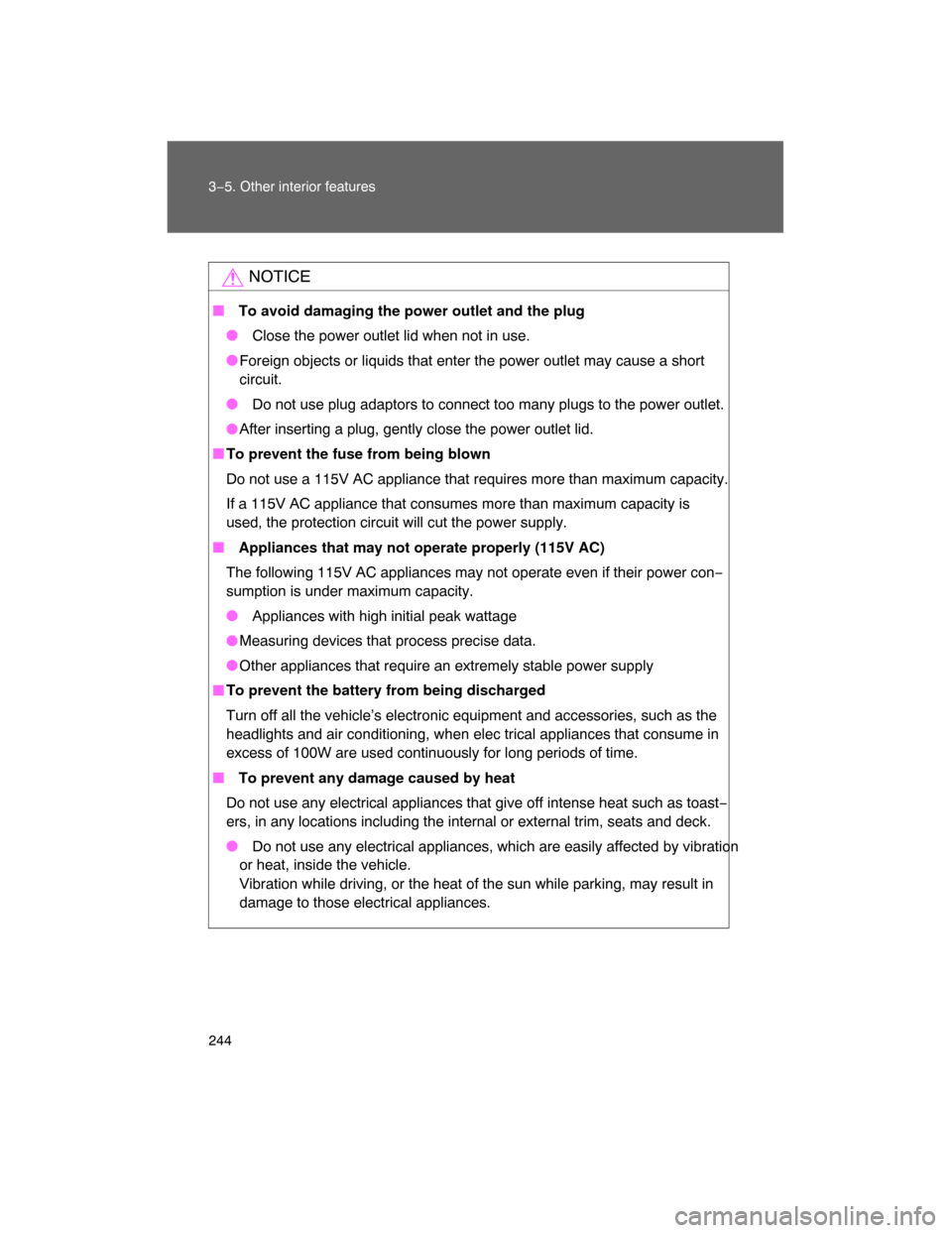Page 4 of 400

TABLE OF CONTENTSIndex
4
Floor mat ............................ 247
Luggage storage box (vehicles
without sub woofer) .......... 248
Luggage compartment
features ............................ 249
Compass ............................ 252
4�1. Maintenance and care ...... 258
Cleaning and protecting the
vehicle exterior ................. 258
Cleaning and protecting the
vehicle interior .................. 260
4�2. Maintenance ..................... 263
Maintenance
requirements .................... 263
General maintenance ......... 265
Emission inspection and
maintenance (I/M)
programs .......................... 268
4�3. Do�it�yourself
maintenance ................... 269
Do−it−yourself service
precautions ...................... 269
Hood ................................... 273
Engine compartment .......... 274
Tires ................................... 287
Tire inflation pressure ......... 292
Wheels ............................... 296
Air conditioning filter ........... 298
Key battery ......................... 301
Checking and replacing
fuses ................................ 303
Light bulbs .......................... 3145�1. Essential information ....... 322
If your vehicle needs to be
towed ................................ 322
If you think something is
wrong ................................ 327
Fuel pump shut off
system .............................. 328
Event data recorder ............ 329
5�2. Steps to take in an
emergency ...................... 331
If a warning light turns on
or a warning buzzer
sounds... ........................... 331
If you have a flat tire ........... 340
If the engine will not start .... 350
If the shift lever cannot be
shifted from P ................... 351
If you lose your keys ........... 352
If the vehicle battery is
discharged ........................ 353
If your vehicle overheats ..... 356
If the vehicle becomes
stuck ................................. 359
6�1. Specifications ................... 362
Maintenance data
(fuel, oil level, etc.) ........... 362
Fuel information .................. 372
Tire information ................... 375
4Maintenance and care
5When trouble arises
6Vehicle specifications
Page 236 of 400
239
3−5. Other interior features
3
Interior features
Power outlet (12V DC)
� The power outlet can be used when
The engine switch is in the ACC or ON position.
NOTICE
� To avoid damaging the power outlet
Close the power outlet lid when not in use.
Foreign objects or liquids that enter the power outlet may cause a short cir−
cuit.
� To prevent the fuse from being blown
Do not use an accessory that uses more than 12V/10A.
�To prevent the battery discharge
Do not use the power outlet longer than necessary when the engine is not
running.
The power outlet can be used for 12 V accessories that run on less
than 10A.
Page 241 of 400

244 3−5. Other interior features
NOTICE
� To avoid damaging the power outlet and the plug
� Close the power outlet lid when not in use.
�Foreign objects or liquids that enter the power outlet may cause a short
circuit.
� Do not use plug adaptors to connect too many plugs to the power outlet.
�After inserting a plug, gently close the power outlet lid.
�To prevent the fuse from being blown
Do not use a 115V AC appliance that requires more than maximum capacity.
If a 115V AC appliance that consumes more than maximum capacity is
used, the protection circuit will cut the power supply.
� Appliances that may not operate properly (115V AC)
The following 115V AC appliances may not operate even if their power con−
sumption is under maximum capacity.
� Appliances with high initial peak wattage
�Measuring devices that process precise data.
�Other appliances that require an extremely stable power supply
�To prevent the battery from being discharged
Turn off all the vehicle’s electronic equipment and accessories, such as the
headlights and air conditioning, when elec trical appliances that consume in
excess of 100W are used continuously for long periods of time.
� To prevent any damage caused by heat
Do not use any electrical appliances that give off intense heat such as toast−
ers, in any locations including the internal or external trim, seats and deck.
� Do not use any electrical appliances, which are easily affected by vibration
or heat, inside the vehicle.
Vibration while driving, or the heat of the sun while parking, may result in
damage to those electrical appliances.
Page 265 of 400

269
4
Maintenance and care
4−3. Do−it−yourself maintenance
Do−it−yourself ser vice precautions
If you perform maintenance yourself, be sure to follow the correct
procedures as given in these sections.
Items Parts and tools
Battery condition ( P. 283)�Warm water
�Baking soda
�Grease
�Conventional wrench
(for terminal clamp bolts)
Brake fluid level ( P. 280)�FMVSS No.116 DOT 3 or SAE
J1703 brake fluid
�Rag or paper towel
�Funnel (used only for adding
brake fluid)
Engine coolant level ( P. 279)�“Toyota Super Long Life Coolant”
or similar high quality ethylene
glycol based non−silicate, non−
amine, non−nitrite and non−borate
coolant with long−life hybrid
organic acid technology.
U.S.A.:
“Toyota Super Long Life Coolant”
is pre−mixed with 50% coolant
and 50% deionized water.
Canada:
“Toyota Super Long Life Coolant”
is pre−mixed with 55% coolant
and 45% deionized water.
�Funnel (used only for adding
engine coolant)
Engine oil level P. 275)�Toyota Genuine Motor Oil or
equivalent
�Rag or paper towel
�Funnel (used only for adding oil)
Fuses ( P. 303)�Fuse with same amperage rating
as original
Page 270 of 400
274
4−3. Do−it−yourself maintenance
Engine compar tment
Washer fluid tank (P. 286)
Power steering fluid reservoir
(P. 282)
Radiator cap
Engine oil level dipstick
(P. 275)
Engine coolant reservoir
(
P. 279)Engine oil filler cap
(P. 275)
Brake fluid reservoir
(P. 280)
Fuse box (
P. 303)
Battery (
P. 283)
Condenser ( P. 280)
Radiator (P. 280)
5214
910
6873
Page 299 of 400
303
4−3. Do−it−yourself maintenance
4
Maintenance and care
Checking and replacing fuses
If any of the electrical componen ts do not operate, a fuse may have
blown. If this happens, check and replace the fuses as necessary.
Turn the engine switch off.
The fuses are located in the following places. To check the
fuses, follow the instructions below.
�
Engine compartment
Ty p e A
Push the tab in and lift the lid
off.
Type B (if equipped)
Push the tab in and lift the lid
off.
Page 300 of 400
304 4−3. Do−it−yourself maintenance
� Under the instrument panel
Remove the lid.
After a system failure, see “Fuse layout and amperage rat−
ings” (
P. 307) for details about which fuse to check.
Page 301 of 400
305
4−3. Do−it−yourself maintenance
4
Maintenance and care
Remove the fuse with the pull−
out tool.
Check if the fuse has blown.